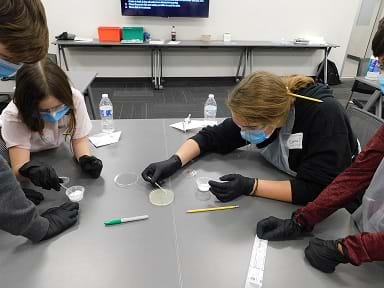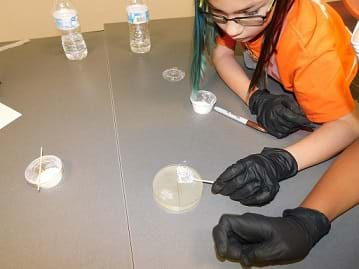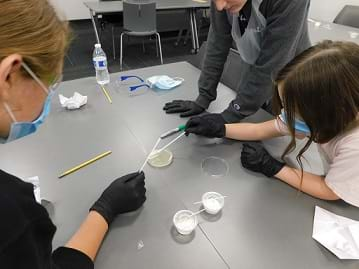Quick Look
Grade Level: 7 (6-8)
Time Required: 1 hours 30 minutes
(two 45-minute periods)
Expendable Cost/Group: US $8.00
Group Size: 2
Activity Dependency: None
Subject Areas: Biology, Life Science
NGSS Performance Expectations:

| MS-LS1-5 |

Summary
What can engineering bacteria in a lab tell us about how to culture or combat them? In this activity, students learn the phenomena that allows us to engineer bacteria on petri dishes with agar as well as how to use a laboratory incubator to speed up bacteria growth. Through this introductory activity, students will learn about the conditions under which bacteria grow, as well as antibiotic-resistant bacteria, and why engineers are turning to nanotechnology to help us understand the bacteria that can help us, or harm us!Engineering Connection
Bacteria is all around us, much of it helpful but some of it harmful to our health and well-being. Engineers work in a variety of fields to help culture good bacteria, but also work to limit the impact of bacterial adaptations with advancements in treatment and prevention. In particular, bioengineers are working to understand bacteria as they potentially become resistant to antibiotics. Nanomaterials like titanium dioxide are being used by engineers in the fight against these bacterial “superbugs.”
Learning Objectives
After this activity, students should be able to:
- Describe the process step-by-step for a growing colony of bacteria within a petri dish.
- Explore how engineering and nanotechnology can assist with the cleaning of our social spaces.
Educational Standards
Each TeachEngineering lesson or activity is correlated to one or more K-12 science,
technology, engineering or math (STEM) educational standards.
All 100,000+ K-12 STEM standards covered in TeachEngineering are collected, maintained and packaged by the Achievement Standards Network (ASN),
a project of D2L (www.achievementstandards.org).
In the ASN, standards are hierarchically structured: first by source; e.g., by state; within source by type; e.g., science or mathematics;
within type by subtype, then by grade, etc.
Each TeachEngineering lesson or activity is correlated to one or more K-12 science, technology, engineering or math (STEM) educational standards.
All 100,000+ K-12 STEM standards covered in TeachEngineering are collected, maintained and packaged by the Achievement Standards Network (ASN), a project of D2L (www.achievementstandards.org).
In the ASN, standards are hierarchically structured: first by source; e.g., by state; within source by type; e.g., science or mathematics; within type by subtype, then by grade, etc.
NGSS: Next Generation Science Standards - Science
| NGSS Performance Expectation | ||
|---|---|---|
|
MS-LS1-5. Construct a scientific explanation based on evidence for how environmental and genetic factors influence the growth of organisms. (Grades 6 - 8) Do you agree with this alignment? |
||
| Click to view other curriculum aligned to this Performance Expectation | ||
| This activity focuses on the following Three Dimensional Learning aspects of NGSS: | ||
| Science & Engineering Practices | Disciplinary Core Ideas | Crosscutting Concepts |
| Construct a scientific explanation based on valid and reliable evidence obtained from sources (including the students' own experiments) and the assumption that theories and laws that describe the natural world operate today as they did in the past and will continue to do so in the future. Alignment agreement: | Genetic factors as well as local conditions affect the growth of the adult plant. Alignment agreement: | Phenomena may have more than one cause, and some cause and effect relationships in systems can only be described using probability. Alignment agreement: |
International Technology and Engineering Educators Association - Technology
-
Biotechnology has applications in such areas as agriculture, pharmaceuticals, food and beverages, medicine, energy, the environment, and genetic engineering.
(Grades
9 -
12)
More Details
Do you agree with this alignment?
State Standards
Texas - Science
-
Scientific investigation and reasoning. The student knows how to use a variety of tools and safety equipment to conduct science inquiry. The student is expected to:
(Grades
6 -
8)
More Details
Do you agree with this alignment?
-
Scientific investigation and reasoning. The student uses scientific inquiry methods during laboratory and field investigations. The student is expected to:
(Grades
6 -
8)
More Details
Do you agree with this alignment?
Materials List
Each group needs:
- petri dish 90 mm × 15 mm
- agar, 10 mL, available online
- spreading tool(s), available online
- permanent marker
- parafilm (to close the petri dish)
- sanitized swabs, 2 per group
- a solution made up of 10% bleach
- titanium oxide, 0.15 mL, available online
- zinc oxide, 0.15 mL, available online
- mini-spoon that holds 0.15 mL
- beakers (or other lab glassware)
- Nano Worksheet, one per student
For the entire class to share:
- autoclave
- hot plate with stir bar
- incubator
- disinfecting wipes
Worksheets and Attachments
Visit [www.teachengineering.org/activities/view/rice2-2527-bacteria-antibiotic-resistance-nanotechnology-activity] to print or download.Pre-Req Knowledge
Students should know about safety equipment that is required to be used in a laboratory setting.
Introduction/Motivation
Do you all wash your hands after using the bathroom? Do you wash your hands before you eat any food? (Let students share.) Do you know why you are asked to wash your hands after using the bathroom and/or before eating any food? (Let students brainstorm why.) Why is it you wash your hands before you eat and after using the bathroom? How many times do you think you have touched your face today? Is there anything on the table in front of you? Is there bacteria in front of you on the table?
Take a moment to watch this video, How Germs Spread, by Cincinnati Children’s https://www.youtube.com/watch?v=YBGsoimPXZg.
Bacteria are microscopic living organisms that can be found everywhere! Bacteria are all around us at all times, regardless of how clean one keeps their personal spaces. There are some Bacteria that are even adapting to antibiotics, which are commonly called “superbugs.” Scientists and engineers are exploring the use of nanoparticles to combat bacteria. We need to understand why it is so important to have clean areas and wash our hands regularly throughout the day.
Today we are going to see how much bacteria are on everyday things we touch like door handles, cell phones, desks, tables, etc. Are you ready?
(Complement the introduction by showing students slides 2-7 of the Bacteria Says What! Presentation, which leads the students through an ice breaker activity, introduces nanotechnology, and summarizes lab safety and personal protective equipment.)
Procedure
Background
Bacteria are around us at all times regardless of how clean one keeps their personal spaces. They are microbial, single-celled organisms. Some bacteria are beneficial, and others cause sickness. Typically, antibiotics are used to treat bacterial infections in people and animals; however, bacteria can adapt and become resistant to antibiotics and thus this treatment becomes less effective or ineffective. These adaptive bacteria are also called superbugs. Scientists are continuously studying antibiotic resistant bacteria in an effort to develop new, effective treatments. One such treatment involves using metal oxide nanoparticles to inhibit bacterial growth. Under the threat of superbugs, it is important to keep hands and commonly used surfaces clean to prevent the spread of bacteria.
Before the Activity
The teacher should create one set of agar dishes for the entire class ahead of the class time so students can experience making the agar plates, but not have to wait the 15 minutes for the agar to set: Dehydrated Media Preparation by Carolina Biological- https://www.youtube.com/watch?v=Q4gY0CSprWE.
With the Students
- Show students slide 8 of the Bacteria Says What! Presentation where students make the agar solution:
- Pour 25 mL water in a beaker.
- Weigh out 0.5 g of agar and add to the beaker.
- Heat the beaker 30 seconds using a hot plate or microwave; do not touch the beaker with bare hands!
- Stir agar with stir plate and stir bar.
- Heat for another 30 seconds.
- Repeat the above steps until the medium is dissolved.
- Pour the solution carefully into petri dish.
- Let sit for 15 minutes (These newly made dishes can be stored and used for the next class period.)
- Put the agar petri dishes off to the side and give students the pre-made dishes. (Alternatively, you can go through the slides while waiting for the petri dishes to set.)
- Introduce nanoparticles and the nanomaterials students will be using in this activity:
- Show slides 9 and 10 of the Bacteria Says What! Presentation. Remind students that nanoparticles like titanium oxide and zinc oxide can be used to combat bacteria.
- Show slide 12 to provide an overview of the sample collection process, where students divide their dish in half on the back side with a sharpie so each pair uses one dish.
- Choose an object for students to swab.
- Objects could be door handles, seats, tables, or anything in the room that has been touched before.
- Have students think of creative sampling methods here.
- Instruct students to make strokes across the side of agar plates with their swabs.
- Place the swabs into a 10% bleach solution or autoclave bin.
- Have students apply titanium dioxide to one half of one side of their petri dish, and zinc oxide to one half of the other side of the dish. Seal the petri dishes with parafilm.
- Place dishes into an incubator at 37°C for 24 hours.
- When students return the following day, have them discuss what changes if any they expect to happen in their dishes.
- Did the colonies grow? What are the shapes and color of the colonies?
- How did the titanium oxide or zinc oxide affect growth?
- Have students retrieve their dishes and record observations of their bacteria from both sides in their notebook or on the Nano Worksheet. Show students slide 12 of the Bacteria Says What! Presentation, which provides information for making observations.
- Use slide 13 to facilitate a class discussion on each petri dish, including bacteria, color, shape, size, and appearance. Ask students to imagine reengineering their dishes to create or prevent growth. How could they make this happen?
- Students will wipe down tables with disinfectant wipes and wash hands after placing materials in bins for cleaning. Autoclave or bleach petri dishes for future use.


Vocabulary/Definitions
agar: A gelatinous substance obtained from various kinds of algae, and used in biological culture media and as a thickener in foods.
bacteria: Microscopic living organisms, usually one-celled, that exist everywhere in the natural world.
cell spreader: Tool used in the biological field to smoothly spread cells and bacteria on a plate or a petri dish.
incubator: An enclosed apparatus providing a controlled environment for bacteria.
nanotechnology: Branch of technology that deals with dimensions and tolerances of less than 100 nanometers, especially the manipulation of individual atoms and molecules.
petri dish: Shallow, circular, transparent dish with a flat lid, used to culture microorganisms.
Assessment
Pre-Activity Assessment
Opening Questions: Ask students the following questions and facilitate a class discussion.
- Why do we wash our hands before eating and after using the bathroom? (Possible answers: to keep bacteria from spreading; to keep ourselves and others healthy; etc.)
- How many times have you touched your face today? (Answers may vary.)
- Is there anything on the table in front of you? Are there any germs? (Answers may vary.)
Post-Activity Assessment
Ending Questions: Prompt students to reflect on what they learned by leading a discussion with the following questions from the Exit Ticket.
- Why is it important for you to wash your hands in the future? (Possible answers: to keep bacteria from spreading; because bacteria can be growing on otherwise clean looking surfaces; etc.)
- What changes could you make in your daily lives to reduce your chance of inviting pathogenic bacteria into or onto your body? (Possible answers: wash hands more often; stop touching my face; clean commonly used surfaces more; etc.)
Safety Issues
- Students need to wear long pants, gloves, masks, glasses, apron, closed-toed shoes, along with following standard laboratory procedures.
- Follow these directions on how to sterilize petri dishes.
Activity Extensions
- Have students determine the type of bacteria in their plates. Allow them to research online or lead them through Part 1 – Data Collection and Analysis in the activity Who's Hitchhiking in Your Food?
Additional Multimedia Support
- Making a biological media from dehydrated agar: https://www.youtube.com/watch?v=Q4gY0CSprWE
Subscribe
Get the inside scoop on all things TeachEngineering such as new site features, curriculum updates, video releases, and more by signing up for our newsletter!More Curriculum Like This

Students culture cells in order to find out which type of surfactant (in this case, soap) is best at removing bacteria. Groups culture cells from unwashed hands and add regular bar soap, regular liquid soap, anti-bacterial soap, dishwasher soap, and hand sanitizer to the cultures.

Students learn which contaminants have the greatest health risks and how they enter the food supply. While food supply contaminants can be identified from cultures grown in labs, bioengineers are creating technologies to make the detection of contaminated food quicker, easier and more effective.
Copyright
© 2020 by Regents of the University of Colorado; original © 2019 Rice UniversityContributors
Elliot HallSupporting Program
Nanotechnology Enabled Water Treatment Systems (NEWT) RET, Rice UniversityAcknowledgements
This curriculum was based upon work supported by the National Science Foundation under Rice University Engineering Research Center for Nanotechnology Enabled Water Treatment Systems (NEWT) RET grant no. 1449500. Any opinions, findings and conclusions or recommendations expressed in this material are those of the authors and do not necessarily reflect the views of the National Science Foundation.
Special thanks to Christina Crawford, Douglas Rice, and François Perrault.
Last modified: November 14, 2020







User Comments & Tips